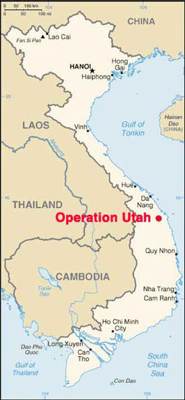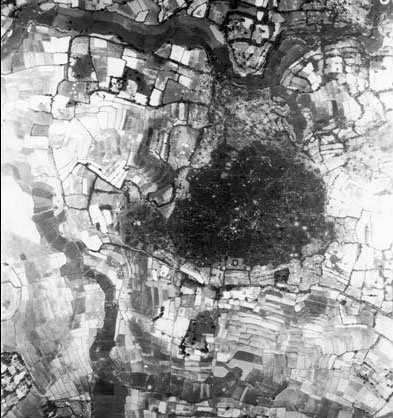Operation Utah — U.S. Marines battle the People’s Vietnam Army

Early in March, 1966, in Quang Ngai Province, South Vietnam, rifle companies from three under-strength Marine Corps battalions engaged elements of the 36th Infantry Regiment of the People’s Vietnam Army. At first, the operation didn’t even have a name. It became known as Operation Utah. The Marines prevailed (with units of the Army of South Vietnam), but at great cost.
For two days, not counting a two-day mopping up period, the Marines faced well-trained, well-armed enemy troops who had, over the previous several months, built and supplied a virtual underground fortress on and around a hillock near Quang Ngai City named Hill 50 because of its 50-metre elevation above sea level.
Among the combatants were Kilo, Lima, and Mike companies of the 3rd Battalion, 1st Marine Regiment, First Marine Division. The Virtual Vietnam Archive contains this brief reference 3/1’s part in Operation Utah; it’s interesting to note how such military/bureaucratic scribblings hide so much blood and suffering:

Among the documents I have collected related to my tour of duty in South Vietnam is a copy of the Operation Utah after-action report signed by Col. J. R. Young, Commander, 3/1/1. Once you work through the military jargon and dispassionate reportage, what emerges are clear illustrations of the bravery of the Marines, ARVN, and North Vietnamese soldiers, of poor military intelligence and planning, and of understated slaughter. After-action reports apparently nlot always available for the Vietnam War. Some have simply disappeared, at least from public view. We veterans of Operation Utah are fortunate to have the report for “our” battle.
Another document held by the Virtual Vietnam Archive is an historical narrative of the events leading up to Operation Utah, of the operation itself, and of its aftermath. It is titled simply “Operation Utah”. In the following version, I have taken the liberty of correcting some spelling and punctuation errors, changed the time references to 24-hour military time, and changed ”NVA” (North Vietnam Army) to “PVN” (Peoples’ Vietnam Army). See the sidebar at the right for the historical background of “PVN”.
Operation Utah: First Contact with the People’s Vietnam Army
The senior USA advisor to the 2d ARVN Division visited with Gen. Platt [in early March] and informed him that reliable sources placed the 21st People’s Vietnam Army Regiment approximately seven miles northwest of Quang Ngai. A coordinated attack was immediately planned using one Marine battalion and one battalion of the Army of the Republic of Vietnam (ARVN).
Gen. Platt ordered his senior Regimental Commander, Col. Peatross, the task of meeting and destroying the enemy forces. Peatross chose his 2nd Battalion, 7th Marines and informed Lt. Col. Leon Utter, the battalion commander, to prepare his men for departure.
The objective area consisted of paddy lands and hamlets of the Chau Nhai village complex with two hills overlooking the planned landing zone. Hill 50, just northeast of the LZ, was the dominant feature in the open rice paddies. The area southwest of that hill proved to be the area of the heaviest fighting during the next few days.

Into battle
On the morning of 4 March, 1966 the objective area was strafed and bombed. Despite the prep of the landing zone, at 0900 hours the first wave of Marine Corps helicopters landing the 1st ARVN Airborne Battalion were taken under heavy ground fire. Anti-aircraft fire downed one of the armed escort UH-1Es and a Marine Phantom F-4 that was making a napalm run. The Marine aviators managed to land all the ARVN troops by 1030 hours. Once on the ground, the South Vietnamese troops met little resistance as they attacked north and then west toward hill 50. Having completed the insertion of the ARVN, the helicopters returned to Chu Lai and would begin to ferry Lt. Col. Utter’s Marines to the objective area. During the first wave, the helicopters were once again taken under fire and the 1st Platoon of Kilo Company was isolated for 15 minutes before the rest of the Company could be landed. Foxtrot and Golf companies and the battalion command group were on the ground by 1130 hours, and met little initial resistance. Hotel Companys’ arrival was delayed until 1300 hours due to heavy ground fire directed at their helicopters. With reports coming in from the battlefield, it was decided to expand the operation and Task Foce Delta was reactivated with Gen. Platt Commanding and Col. Peatross as his Chief of Staff. A command post was set up on Nui Tien An (Buddah Hill) just north of Quang Ngai City in close proximity to the 2d ARVN Division Headquarters, which was located in Quang Ngai City.
Utter’s Battalion engages the enemy
Shortly after 1300 hours, the Marines secured Hills 97 and 85. They began moving south toward the ARVN, who had taken Hill 50 but were encountering strong opposition and asking for help. Lt. Col. Utter received permission and began moving his companies toward the ARVN. However, he had to adjust his movement because the South Vietnamese hadn’t moved forward according to plan. Advancing in a general easterly direction, the battalion, with Foxtrot Company on the left, Golf Company in the center, and Hotel Company in an echelon formation, pushed forward for a few hundred metres before they were taken under heavy fire from what was later estimated to be two battalions of the 21st PVA Regiment. The enemy fought from well-prepared positions which were too close for the Marines to call in artillery or airs trikes. Golf Company penetrated the enemy positions in two places but the Marines couldn’t take advantage of these minor gains because of a lack of reserves. Enemy machine-gun fire was so heavy at times that it actually destroyed sections of the rice-paddy dikes. Hotel Company, on the Battalion’s right, made some progress when the PVA counterattacked. The attack was repulsed when the Marines’ company commander used his 81mm mortars with good effect. There was a growing gap on the Marine battalions left flank. The ARVN, who were asked to close it but refused to do so, left Foxtrot Company on the exposed left flank and most vulnerable to attack.
Foxtrot Co. takes heavy casualties
The enemy struck Foxtrot Company with a heavy volume of fire, causing the entire Company to take heavy casualties and cutting off the 1st and lead platoon from the rest of the Company. The company commander was wounded and reported his situation to the battalion command post. A replacement was dispatched immediately and reached the embattled Marines under heavy fire. Taking command of the embattled Marines he reported immediately that the situation was serious and that the Marines were running out of ammunition. A platoon of Hotel Company was sent as reinforcements, but the whole battalion’s position remained precarious and Utter ordered all of his companies to fall back. Hotel Company came under heavy 60mm mortar fire, with the enemy advancing towards the Marines. The attack was repulsed with air strikes, using bombs, rockets and napalm that were called in on the enemy until the battalion reached its night defensive positions near Chau Nhai.
During the night of 4-5 March, the enemy continued to harass the 2nd Battalion, 7th Marines, particularly when helicopters arrived. Hotel Company took a trench line in a night assault and killed 20 PVA when they revealed themselves by firing 60mm mortars at the Marines and machine-guns at the resupply helicopters. Much-needed supplies were brought in to the Marines and 70 casualties were evacuated by those brave helicopter pilots who flew through a hail of steel each time they arrived to the Battalions perimeter.
With the heavy contact and loss of personnel, Gen. Platt ordered another 155mm Battery deployed to Binh Son, and also ordered the 3rd Battalion, 1st Marines to establish blocking defenses north of Utter’s Battalion. Lt. Col. P. X. Kelly’s 2nd Battalion, 4th Marines was ordered to stand by in Chu Lai and be ready for deployment in the morning.
Lima & Mike Companies, 3/1/1, advance toward Hill 50
The PVA stuck the ARVN near Hill 50 around 0500 hours on 5 March. Marine Corps artillery batteries fired 1,900 rounds in support for a period of two hours, and the 1st Marines were ordered to leave their blocking positions and advance south towards Hill 50.


While the 1st Marines were to link with the ARVN under attack, the ARVN 2nd Division Commander ordered additional ARVN troops to join the operation in progress. The 2nd Battalion, 7th Marines was ordered to clear a landing zone of the arrival of fresh troops, clear its battlefield from the previous day, and serve as the Task Force Delta reserve unit. Kelly’s Marines began landing shortly after 0830 hours, and the helicopters once again were immediately taken under fire. Several helicopters were put out of commission before all the troops were on the ground and moving towards their objectives. Two Companies of the 2nd Battalion, 4th Marines engaged the PVA at close quarters but persevered until all the companies reached Lt. Col. Utter’s battalion and established night defensive positions.
Lima Company takes Hill 50
North of Utter’s and Kelley’s Marines, the 3rd Battalion, 1st Marines, under the command of Lt. Col. J.R. Young, were slugging it out with a persistent enemy who was dug into a network of interconnected tunnels, bunkers and spider traps on Hill 50. Despite these defenses, the Marines pressed the attack. Lima Company succeeding in taking Hill 50 after a three-hour engagement. Little headway was made in the vicinity of Chau Ngai (3), and with the coming of darkness the Marines were forced to withdraw.
The 3rd Battalion, 7th Marines’ losses for the day were 32 killed and 90 wounded. The 3rd Battalion, 1st Marines had 42 killed and 102 wounded.
Bravo Company, 1st Battalion, 7th Marines, which had been attached to the 4th Marines and guarding a downed helicopter, came under heavy small arms fire and a mortar attack. The Marines came under increasing pressure and at about 0130 hours the PVA launched a three-pronged assault. This was repulsed with the help of supporting artillery fire. By morning, when relief arrived, 38 enemy dead were found. Twice that number were believed to have been carried away during the previous night. The Marines and ARVN pulled back and a intensive two and one-half hour air and artillery bombardment was launched. At approximately 1240 hours on 6 March, the three battalions advanced but the North Vietnamese were no longer there.
Casualties
A search of the area revealed a cave complex which apparently served as the PVA Regimental Command Post, and 100 enemy bodies on Hill 50 were found by the 1st Marines. Lt. Col. Utter’s Marines discovered 43 enemy bodies in another tunnel complex. During Operation Utah, the allied forces claimed to have killed 600 North Vietnamese soldiers, captured five prisoners and 49 weapons including three 12.7mm machine-guns and two mortars. Total Marine casualties were 98 dead and 278 wounded, while the ARVN lost 30 killed and 120 wounded. The battle had been hard fought and won by Marines who stood their ground.